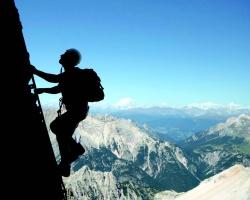“It’s not running. It’s not walking. It’s surviving.”
That’s how Rulon Gardner, the Olympic gold-winning Greco-Roman wrestler, describes the Incline, a 2,000-foot uphill scar carved into the base of Pikes Peak, the towering mountain abutting the cities of Manitou Springs and Colorado Springs.
People who climb the Incline gain those 2,000 feet in elevation over the course of about one mile. The hike is punishing. Speedskater Apolo Ohno calls it “truly unbeatable. It is you against yourself.”
A recent New York Times story profiled the Incline and the many Olympians who train there, but they aren’t alone. City residents crowd the Incline most every day of the year. Even in winter months, you can find intrepid athletes forcing themselves up the railroad-tie-pocked trail.
Two summers ago, I learned some friends had begun to meet at the trailhead on Tuesday mornings each week. I watched in wonder from afar, promising to join them sometime but never actually daring to try.
Then this past summer, my friend Jeff talked me in to trying the Incline with him just once. I pulled myself out of bed before dawn one morning and headed with him toward the Incline. I talked as much as I could on the way there, not letting myself think about the pain I’d soon be experiencing.
I spent the entire way up looking at my feet; dreading every next step; wondering when I could turn back; watching the tanned, skinny grandmother pass me on my left, the 12-year-old gain on me from below; guessing how many times I could stop to rest before Jeff abandoned me in frustration. My feet hurt. My lungs burned. My head pulsated.
We got to the top, and I didn’t feel one lick better. I wanted to curl into a ball and roll down. You know what the sorest part of my body was for the next two days? It wasn’t my feet or legs but my trapezius muscles. I had been clenching my shoulders the entire time—nervous, scared, clenched.
I’ve written in this space before about the terrible and the ugly, the great trials of life that sometimes have left me immobile. I’ve talked about the value of embracing pain, being intimate with it, knowing it inside and out rather than ignoring it, and how hope in Christ calls us to keep moving in the face of despair.
These past few weeks, as I’ve done the Incline at least once a week since the first time, I’ve had a regular reminder of how pain and hope are linked.
I’ve changed how I do the uphill climb: looking up, still in great, GREAT pain for much of the way; but controlling my breath; willing my legs; choosing my steps carefully; encouraging those who stop to rest along the way; and enjoying those who pass me in greater strength.
Then, I embrace the run down. The descent has three miles of switchbacks, which we run with abandon to the bottom, where a mountain stream awaits us to cool our heads and offer a few moments of earned sanctuary. During the run, I do my best to enjoy every rock, wildflower and evergreen jutting out of the mountain. I praise God for His tenderness in the blue sky, the rising sun and the mammoth 14,000-foot peak towering above me. I see Him expressing Himself in His creation; and I enjoy it, even as it is “truly unbeatable.”
Find an Incline. Get out of bed. Climb. Breathe in. Breathe out. Get to know your misery, your challenge. Choose hope—and celebrate.




